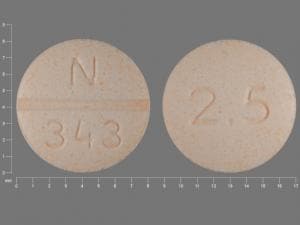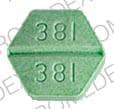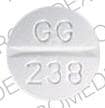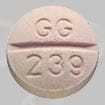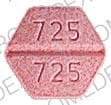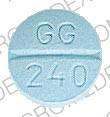Dosage Forms
Excipient information presented when available (limited, particularly for generics); consult specific product labeling. [DSC] = Discontinued product
Tablet, Oral:
Diabeta: 1.25 mg [DSC], 2.5 mg [DSC], 5 mg [DSC]
Glynase: 1.5 mg, 3 mg, 6 mg [scored]
Generic: 1.25 mg, 1.5 mg, 2.5 mg, 3 mg, 5 mg, 6 mg
Pharmacology
Mechanism of Action
Stimulates insulin release from the pancreatic beta cells; reduces glucose output from the liver; insulin sensitivity is increased at peripheral target sites
Pharmacokinetics/Pharmacodynamics
Absorption
Significant within 1 hour
Metabolism
Hepatic; forms metabolites (weakly active)
Excretion
Feces (50%) and urine (50%) as metabolites
Onset of Action
Serum insulin levels begin to increase 15-60 minutes after a single dose
Time to Peak
Serum: Adults: 2-4 hours
Duration of Action
≤24 hours
Half-Life Elimination
Diaβeta: 10 hours; Glynase PresTab: ~4 hours; may be prolonged with renal or hepatic impairment
Protein Binding
Plasma: Extensive, primarily to albumin
Use: Labeled Indications
Diabetes mellitus, type 2: Adjunct to diet and exercise to improve glycemic control in adults with type 2 diabetes mellitus
Contraindications
Hypersensitivity to glyburide or any component of the formulation; type 1 diabetes mellitus or diabetic ketoacidosis, with or without coma; concomitant use with bosentan.
Canadian labeling: Additional contraindications (not in US labeling): Hypersensitivity to any sulfonylurea or sulfonamide; diabetic precoma or coma, stress conditions (eg, severe infections, trauma, surgery); liver disease or frank jaundice; renal impairment; pregnancy; breastfeeding.
Documentation of allergenic cross-reactivity for sulfonylureas is limited. However, because of similarities in chemical structure and/or pharmacologic actions, the possibility of cross-sensitivity cannot be ruled out with certainty.
Dosage and Administration
Dosing: Adult
Micronized glyburide tablets are not bioequivalent to conventional glyburide tablets; retitration should occur if patients are being transferred to a different glyburide formulation (eg, micronized-to-conventional or vice versa) or from other hypoglycemic agents. When converting to glyburide from other oral hypoglycemic agents with a long half-life (eg, chlorpropamide), observe patient carefully for 2 weeks due to overlapping hypoglycemic effects.
Diabetes mellitus, type 2: Oral:
Note: Sulfonylureas may be considered as adjunctive or alternative monotherapy for patients who have suboptimal response to or cannot take metformin; however, sulfonylureas are known to have a relatively high risk of hypoglycemia as compared to other noninsulin antidiabetic agents due to their mechanism of action. If a sulfonylurea is chosen, agents other than glyburide are preferred (AACE/ACE [Garber 2019]; ADA 2019).
Conventional tablets (Diaβeta):
Initial: 2.5 to 5 mg/day, administered with breakfast or the first main meal of the day. In patients who are more sensitive to hypoglycemic drugs, start at 1.25 mg/day.
Dosage adjustment: Increase in increments of no more than 2.5 mg/day at weekly intervals based on the patient's blood glucose response
Maintenance: 1.25 to 20 mg/day given as single or divided doses. Some patients (especially those receiving >10 mg/day) may have a more satisfactory response with twice-daily dosing. Maximum: 20 mg/day
Micronized tablets (Glynase PresTab):
Initial: 1.5 to 3 mg/day, administered with breakfast or the first main meal of the day. In patients who are more sensitive to hypoglycemic drugs, start at 0.75 mg/day
Dosage adjustment: Increase in increments of no more than 1.5 mg/day in weekly intervals based on the patient's blood glucose response.
Maintenance: 0.75 to 12 mg/day given as a single dose or in divided doses. Some patients (especially those receiving >6 mg/day) may have a more satisfactory response with twice-daily dosing. Maximum: 12 mg/day
Management of noninsulin-dependent diabetes mellitus in patients previously maintained on insulin: Oral: Initial dosage dependent upon current insulin dosage, see table.
|
Current Daily Insulin Dosage (units daily) |
Initial Glyburide Dosage Conventional Formulation (mg daily) |
Initial Glyburide Dosage Micronized Formulation (mg daily) |
Insulin Dosage Change (after glyburide started) |
|---|---|---|---|
|
<20 |
2.5 to 5 |
1.5 to 3 |
Discontinue |
|
20 to 40 |
5 |
3 |
Discontinue |
|
>40 |
5 (increase in increments of 1.25 to 2.5 mg every 2 to 10 days) |
3 (increase in increments of 0.75 to 1.5 mg every 2 to 10 days) |
Reduce insulin dosage by 50% (gradually taper off insulin as glyburide dosage increased) |
Table has been converted to the following text.
Dose Conversion: Insulin to Glyburide
Current insulin dose: <20 units daily
- Initial daily glyburide dose: 2.5 to 5 mg (conventional formulation) OR 1.5 to 3 mg (micronized formulation)
- Discontinue insulin after glyburide is started.
Current insulin dose: 20 to 40 units daily
- Initial daily glyburide dose: 5 mg (conventional formulation) OR 3 mg (micronized formulation).
- Discontinue insulin after glyburide is started.
Current insulin dose: >40 units daily
- Initial daily glyburide dose: 5 mg (conventional formulation) and increase in increments of 1.25 to 2.5 mg every 2 to 10 days OR 3 mg (micronized formulation) and increase in increments of 0.75 to 1.5 mg every 2 to 10 days.
- Reduce insulin dosage by 50%; gradually taper off insulin as glyburide dosage is increased.
Dosing: Geriatric
Avoid use (Beers Criteria [AGS 2019]).
Administration
Oral: Administer with meals at the same time each day (twice-daily dosing may be beneficial if conventional glyburide doses are >10 mg or micronized glyburide doses are >6 mg). Patients that are NPO or require decreased caloric intake may need doses held to avoid hypoglycemia.
Dietary Considerations
Should be taken with meals at the same time each day (twice-daily dosing may be beneficial if conventional glyburide doses are >10 mg or micronized glyburide doses are >6 mg). Individualized medical nutrition therapy (MNT) based on ADA recommendations is an integral part of therapy.
Storage
Conventional tablets (Diaβeta): Store at 25°C (77°F); excursions are permitted between 15°C and 30°C (59°F and 86°F).
Micronized tablets (Glynase PresTab): Store at 20°C to 25°C (68°F to 77°F).
GlyBURIDE Images
Drug Interactions
Ajmaline: Sulfonamides may enhance the adverse/toxic effect of Ajmaline. Specifically, the risk for cholestasis may be increased. Monitor therapy
Alcohol (Ethyl): Sulfonylureas may enhance the adverse/toxic effect of Alcohol (Ethyl). A flushing reaction may occur. Monitor therapy
Alpelisib: May decrease the serum concentration of CYP2C9 Substrates (High risk with Inducers). Monitor therapy
Alpha-Lipoic Acid: May enhance the hypoglycemic effect of Antidiabetic Agents. Monitor therapy
Aminolevulinic Acid (Systemic): Photosensitizing Agents may enhance the photosensitizing effect of Aminolevulinic Acid (Systemic). Avoid combination
Aminolevulinic Acid (Topical): Photosensitizing Agents may enhance the photosensitizing effect of Aminolevulinic Acid (Topical). Monitor therapy
Androgens: May enhance the hypoglycemic effect of Blood Glucose Lowering Agents. Exceptions: Danazol. Monitor therapy
Antidiabetic Agents: May enhance the hypoglycemic effect of Hypoglycemia-Associated Agents. Monitor therapy
Beta-Blockers: May enhance the hypoglycemic effect of Sulfonylureas. Cardioselective beta-blockers (eg, acebutolol, atenolol, metoprolol, and penbutolol) may be safer than nonselective beta-blockers. All beta-blockers appear to mask tachycardia as an initial symptom of hypoglycemia. Ophthalmic beta-blockers are probably associated with lower risk than systemic agents. Exceptions: Levobunolol; Metipranolol. Monitor therapy
Bosentan: GlyBURIDE may enhance the hepatotoxic effect of Bosentan. GlyBURIDE may decrease the serum concentration of Bosentan. Bosentan may decrease the serum concentration of GlyBURIDE. Avoid combination
Carbocisteine: Sulfonylureas may enhance the adverse/toxic effect of Carbocisteine. Specifically, sulfonylureas may enhance adverse effects of alcohol that is present in liquid formulations of carbocisteine-containing products. Monitor therapy
Chloramphenicol (Systemic): May decrease the metabolism of Sulfonylureas. Monitor therapy
Cimetidine: May increase the serum concentration of Sulfonylureas. Monitor therapy
Clarithromycin: May increase the serum concentration of GlyBURIDE. Monitor therapy
Colesevelam: May decrease the serum concentration of GlyBURIDE. Management: Administer glyburide at least 4 hours prior to colesevelam. Consider therapy modification
Cyclic Antidepressants: May enhance the hypoglycemic effect of Sulfonylureas. Monitor therapy
CycloSPORINE (Systemic): May diminish the therapeutic effect of GlyBURIDE. GlyBURIDE may increase the serum concentration of CycloSPORINE (Systemic). Monitor therapy
CYP2C9 Inhibitors (Moderate): May decrease the metabolism of CYP2C9 Substrates (High risk with Inhibitors). Monitor therapy
Dabrafenib: May decrease the serum concentration of CYP2C9 Substrates (High risk with Inducers). Management: Seek alternatives to the CYP2C9 substrate when possible. If concomitant therapy cannot be avoided, monitor clinical effects of the substrate closely (particularly therapeutic effects). Consider therapy modification
Dexketoprofen: May enhance the adverse/toxic effect of Sulfonamides. Monitor therapy
Dipeptidyl Peptidase-IV Inhibitors: May enhance the hypoglycemic effect of Sulfonylureas. Management: Consider a decrease in sulfonylurea dose when initiating therapy with a dipeptidyl peptidase-IV inhibitor and monitor patients for hypoglycemia. Consider therapy modification
Direct Acting Antiviral Agents (HCV): May enhance the hypoglycemic effect of Antidiabetic Agents. Monitor therapy
Enzalutamide: May decrease the serum concentration of CYP2C9 Substrates (High risk with Inducers). Management: Concurrent use of enzalutamide with CYP2C9 substrates that have a narrow therapeutic index should be avoided. Use of enzalutamide and any other CYP2C9 substrate should be performed with caution and close monitoring. Consider therapy modification
Fibric Acid Derivatives: May enhance the hypoglycemic effect of Sulfonylureas. Monitor therapy
Fluconazole: May increase the serum concentration of Sulfonylureas. Management: Seek alternatives when possible. If used together, monitor closely for increased effects of sulfonylureas if fluconazole is initiated/dose increased, or decreased effects if fluconazole is discontinued/dose decreased. Consider therapy modification
Glucagon-Like Peptide-1 Agonists: May enhance the hypoglycemic effect of Sulfonylureas. Management: Consider sulfonylurea dose reductions when used in combination with glucagon-like peptide-1 agonists. Consider therapy modification
Guanethidine: May enhance the hypoglycemic effect of Antidiabetic Agents. Monitor therapy
Herbs (Hypoglycemic Properties): May enhance the hypoglycemic effect of Hypoglycemia-Associated Agents. Monitor therapy
Hyperglycemia-Associated Agents: May diminish the therapeutic effect of Antidiabetic Agents. Monitor therapy
Hypoglycemia-Associated Agents: May enhance the hypoglycemic effect of other Hypoglycemia-Associated Agents. Monitor therapy
Hypoglycemia-Associated Agents: Antidiabetic Agents may enhance the hypoglycemic effect of Hypoglycemia-Associated Agents. Monitor therapy
Letermovir: May increase the serum concentration of GlyBURIDE. Monitor therapy
Lumacaftor and Ivacaftor: May decrease the serum concentration of CYP2C9 Substrates (High Risk with Inhibitors or Inducers). Lumacaftor and Ivacaftor may increase the serum concentration of CYP2C9 Substrates (High Risk with Inhibitors or Inducers). Monitor therapy
Maitake: May enhance the hypoglycemic effect of Blood Glucose Lowering Agents. Monitor therapy
Mecamylamine: Sulfonamides may enhance the adverse/toxic effect of Mecamylamine. Avoid combination
Metreleptin: May enhance the hypoglycemic effect of Sulfonylureas. Management: Sulfonylurea dosage adjustments (including potentially large decreases) may be required to minimize the risk for hypoglycemia with concurrent use of metreleptin. Monitor closely. Consider therapy modification
Miconazole (Oral): May enhance the hypoglycemic effect of Sulfonylureas. Miconazole (Oral) may increase the serum concentration of Sulfonylureas. Monitor therapy
MiFEPRIStone: May increase the serum concentration of CYP2C9 Substrates (High risk with Inhibitors). Management: Use CYP2C9 substrates at the lowest recommended dose, and monitor closely for adverse effects, during and in the 2 weeks following mifepristone treatment. Consider therapy modification
Mitiglinide: May enhance the adverse/toxic effect of Sulfonylureas. Avoid combination
Monoamine Oxidase Inhibitors: May enhance the hypoglycemic effect of Blood Glucose Lowering Agents. Monitor therapy
Pegvisomant: May enhance the hypoglycemic effect of Blood Glucose Lowering Agents. Monitor therapy
Porfimer: Photosensitizing Agents may enhance the photosensitizing effect of Porfimer. Monitor therapy
Probenecid: May decrease the protein binding of Sulfonylureas. Probenecid may increase the serum concentration of Sulfonylureas. Monitor therapy
Prothionamide: May enhance the hypoglycemic effect of Blood Glucose Lowering Agents. Monitor therapy
Quinolones: May enhance the hypoglycemic effect of Blood Glucose Lowering Agents. Quinolones may diminish the therapeutic effect of Blood Glucose Lowering Agents. Specifically, if an agent is being used to treat diabetes, loss of blood sugar control may occur with quinolone use. Monitor therapy
RaNITIdine: May increase the serum concentration of Sulfonylureas. Monitor therapy
RifAMPin: May decrease the serum concentration of Sulfonylureas. Management: Seek alternatives to these combinations when possible. Monitor closely for diminished therapeutic effects of sulfonylureas if rifampin is initiated/dose increased, or enhanced effects if rifampin is discontinued/dose decreased. Consider therapy modification
Rifapentine: May decrease the serum concentration of CYP2C9 Substrates (High risk with Inducers). Monitor therapy
Ritodrine: May diminish the therapeutic effect of Antidiabetic Agents. Monitor therapy
Salicylates: May enhance the hypoglycemic effect of Blood Glucose Lowering Agents. Monitor therapy
Selective Serotonin Reuptake Inhibitors: May enhance the hypoglycemic effect of Blood Glucose Lowering Agents. Monitor therapy
Sodium-Glucose Cotransporter 2 (SGLT2) Inhibitors: May enhance the hypoglycemic effect of Sulfonylureas. Management: Consider a decrease in sulfonylurea dose when initiating therapy with a sodium-glucose cotransporter 2 inhibitor and monitor patients for hypoglycemia. Consider therapy modification
SORAfenib: May enhance the hypoglycemic effect of GlyBURIDE. Monitor therapy
Sulfonamide Antibiotics: May enhance the hypoglycemic effect of Sulfonylureas. Monitor therapy
Thiazide and Thiazide-Like Diuretics: May diminish the therapeutic effect of Antidiabetic Agents. Monitor therapy
Thiazolidinediones: May enhance the hypoglycemic effect of Sulfonylureas. Management: Consider sulfonylurea dose adjustments in patients taking thiazolidinediones and monitor for hypoglycemia. Consider therapy modification
Tolvaptan: May increase the serum concentration of GlyBURIDE. Consider therapy modification
Verteporfin: Photosensitizing Agents may enhance the photosensitizing effect of Verteporfin. Monitor therapy
Vitamin K Antagonists (eg, warfarin): Sulfonylureas may enhance the anticoagulant effect of Vitamin K Antagonists. Vitamin K Antagonists may enhance the hypoglycemic effect of Sulfonylureas. Monitor therapy
Voriconazole: May increase the serum concentration of Sulfonylureas. Monitor therapy
Adverse Reactions
1% to 10%:
Gastrointestinal: Epigastric fullness (≤2%), heartburn (≤2%), nausea (≤2%)
Hypersensitivity: Hypersensitivity reaction (2%; including erythema, maculopapular rash, morbilliform rash, pruritus, urticaria)
Frequency not defined:
Central nervous system: Disulfiram-like reaction
Endocrine & metabolic: Hypoglycemia, hyponatremia, weight gain
Genitourinary: Diuresis (minor)
Hematologic & oncologic: Hemolytic anemia
Hepatic: Cholestatic jaundice, hepatic failure, hepatitis
<1%, postmarketing, and/or case reports: Accommodation disturbance, angioedema, arthralgia, blurred vision, bullous rash, erythema multiforme, exfoliative dermatitis, increased serum transaminases, myalgia, vasculitis
Warnings/Precautions
Concerns related to adverse reactions:
- Cardiovascular mortality: Product labeling states oral hypoglycemic drugs may be associated with an increased cardiovascular mortality as compared to treatment with diet alone or diet plus insulin. Data to support this association are limited, and several studies, including a large prospective trial (UKPDS), have not supported an association. In patients with established atherosclerotic cardiovascular disease (ASCVD), other agents are preferred (ADA 2019).
- Hypoglycemia: All sulfonylurea drugs are capable of producing severe hypoglycemia. Hypoglycemia is more likely to occur when caloric intake is deficient, after severe or prolonged exercise, when ethanol is ingested, or when more than one glucose-lowering drug is used. It is also more likely in elderly patients, malnourished or debilitated patients, and in patients with severe renal and hepatic impairment, adrenal and/or pituitary insufficiency; use with caution.
- Sulfonamide (“sulfa”) allergy: The FDA-approved product labeling for many medications containing a sulfonamide chemical group includes a broad contraindication in patients with a prior allergic reaction to sulfonamides. There is a potential for cross-reactivity between members of a specific class (eg, two antibiotic sulfonamides). However, concerns for cross-reactivity have previously extended to all compounds containing the sulfonamide structure (SO2NH2). An expanded understanding of allergic mechanisms indicates cross-reactivity between antibiotic sulfonamides and nonantibiotic sulfonamides may not occur or at the very least this potential is extremely low (Brackett 2004; Johnson 2005; Slatore 2004; Tornero 2004). In particular, mechanisms of cross-reaction due to antibody production (anaphylaxis) are unlikely to occur with nonantibiotic sulfonamides. T-cell-mediated (type IV) reactions (eg, maculopapular rash) are less well understood and it is not possible to completely exclude this potential based on current insights. In cases where prior reactions were severe (Stevens-Johnson syndrome/TEN), some clinicians choose to avoid exposure to these classes.
Disease-related concerns:
- Bariatric surgery:
– Altered absorption: Use IR formulations after surgery to minimize the potential effects of bypassing stomach and proximal small bowel with gastric bypass or more rapid gastric emptying and proximal small bowel transit with sleeve gastrectomy (Apovian 2015). ER formulations may have altered release and absorption patterns after gastric bypass or sleeve gastrectomy (but not gastric band). Compared to control, Tmax in a gastric bypass cohort administered tolbutamide was significantly shorter (1.4 ± 1.8 vs 5.1 ± 1.7 hours; P < 0.001), while Cmax and AUC0-∞ were not altered (Tandra 2013).
– Hypoglycemia: Use an antidiabetic agent without the potential for hypoglycemia if possible; hypoglycemia may occur after gastric bypass, sleeve gastrectomy, and gastric band (Mechanick 2013). Insulin secretion and sensitivity may be partially or completely restored after these procedures (gastric bypass is most effective, followed by sleeve and finally band) (Korner 2009; Peterli 2012). First-phase insulin secretion and hepatic insulin sensitivity have been shown to be significantly improved in the immediate days after gastric bypass and sleeve gastrectomy. The restorative effects of these procedures on peripheral insulin sensitivity may occur later in the 3- to 12-month period postsurgery (Mingrone 2016).
– Weight gain: Evaluate risk vs benefit and consider alternative therapy after gastric bypass, sleeve gastrectomy, and gastric banding; weight gain may occur (Apovian 2015).
- Glucose-6-phosphate dehydrogenase deficiency: Patients with glucose-6-phosphate dehydrogenase (G6PD) deficiency may be at an increased risk of sulfonylurea-induced hemolytic anemia; however, cases have also been described in patients without G6PD deficiency during postmarketing surveillance. Use with caution and consider a nonsulfonylurea alternative in patients with G6PD deficiency.
- Renal impairment: The metabolism and excretion of glyburide may be slowed in patients with renal impairment and its active metabolites may accumulate in advanced renal insufficiency (Snyder 2004). If hypoglycemia should occur, it may be prolonged. Use of glyburide is generally not recommended in chronic kidney disease (ADA [Tuttle 2014]; Alsahli 2015; KDOQI [Nelson 2012]).
- Stress-related states: It may be necessary to discontinue therapy and administer insulin if the patient is exposed to stress (fever, trauma, infection, surgery).
Special populations:
- Elderly: Glyburide is a longer-duration sulfonylurea; avoid use in older adults due to potential for severe hypoglycemia (Beers Criteria [AGS 2019]). If sulfonylureas are used, those of shorter duration (eg, glipizide) are preferred (ADA 2019).
Dosage form specific issues:
- Glyburide tablet formulations: Micronized glyburide tablets are not bioequivalent to conventional glyburide tablets; retitration should occur if patients are being transferred to a different glyburide formulation (eg, micronized-to-conventional or vice versa) or from other hypoglycemic agents.
Other warnings/precautions:
- Appropriate use: Not for use in patients with diabetic ketoacidosis (DKA) or patients with type 1 diabetes mellitus.
- Secondary failure: Loss of efficacy may be observed following prolonged use as a result of the progression of type 2 diabetes mellitus which results in continued beta cell destruction. In patients who were previously responding to sulfonylurea therapy, consider additional factors which may be contributing to decreased efficacy (eg, inappropriate dose, nonadherence to diet and exercise regimen). If no contributing factors can be identified, consider discontinuing use of the sulfonylurea due to secondary failure of treatment. Additional antidiabetic therapy (eg, insulin) will be required.
Monitoring Parameters
Signs and symptoms of hypoglycemia, urine glucose test, fasting blood glucose, hemoglobin A1c (at least twice yearly in patients who have stable glycemic control and are meeting treatment goals; quarterly in patients not meeting treatment goals or with therapy change [ADA 2019])
Pregnancy
Pregnancy Considerations
Glyburide crosses the placenta.
Severe hypoglycemia lasting 4 to 10 days has been noted in infants born to mothers taking a sulfonylurea at the time of delivery. Additional adverse maternal and fetal events have been noted in some studies and may be influenced by maternal glycemic control and/or differences in study design (Bertini 2005; Ekpebegh 2007; Joy 2012; Langer 2000; Langer 2005). According to the manufacturer, if glyburide is used during pregnancy, it should be discontinued at least 2 weeks before the expected delivery date. Due to pregnancy-induced physiologic changes, some pharmacokinetic properties of glyburide may be altered (Hebert 2009).
Poorly controlled diabetes during pregnancy can be associated with an increased risk of adverse maternal and fetal outcomes, including diabetic ketoacidosis, preeclampsia, spontaneous abortion, preterm delivery, delivery complications, major birth defects, stillbirth, and macrosomia (ACOG 201 2018). To prevent adverse outcomes, prior to conception and throughout pregnancy, maternal blood glucose and HbA1c should be kept as close to target goals as possible but without causing significant hypoglycemia (ADA 2020; Blumer 2013).
Glyburide has been evaluated for the treatment of gestational diabetes mellitus. However, because glyburide crosses the placenta, long-term safety data are not available, and adverse events have been observed, glyburide should not be recommended as an initial alternative therapy (ACOG 190 2018; ADA 2020).
Agents other than glyburide are currently recommended to treat diabetes mellitus in pregnancy (ADA 2020).
Patient Education
What is this drug used for?
- It is used to lower blood sugar in patients with high blood sugar (diabetes).
Frequently reported side effects of this drug
- Nausea
- Heartburn
- Weight gain
- Bloating
Other side effects of this drug: Talk with your doctor right away if you have any of these signs of:
- Liver problems like dark urine, fatigue, lack of appetite, nausea, abdominal pain, light-colored stools, vomiting, or yellow skin.
- Low sodium like headache, difficulty focusing, trouble with memory, confusion, weakness, seizures, or change in balance.
- Low blood sugar like dizziness, headache, fatigue, feeling weak, shaking, fast heartbeat, confusion, increased hunger, or sweating.
- Infection
- Severe loss of strength and energy
- Vision changes
- Muscle pain
- Joint pain
- Bruising
- Bleeding
- Signs of a significant reaction like wheezing; chest tightness; fever; itching; bad cough; blue skin color; seizures; or swelling of face, lips, tongue, or throat.
Note: This is not a comprehensive list of all side effects. Talk to your doctor if you have questions.
Consumer Information Use and Disclaimer: This information should not be used to decide whether or not to take this medicine or any other medicine. Only the healthcare provider has the knowledge and training to decide which medicines are right for a specific patient. This information does not endorse any medicine as safe, effective, or approved for treating any patient or health condition. This is only a brief summary of general information about this medicine. It does NOT include all information about the possible uses, directions, warnings, precautions, interactions, adverse effects, or risks that may apply to this medicine. This information is not specific medical advice and does not replace information you receive from the healthcare provider. You must talk with the healthcare provider for complete information about the risks and benefits of using this medicine.
